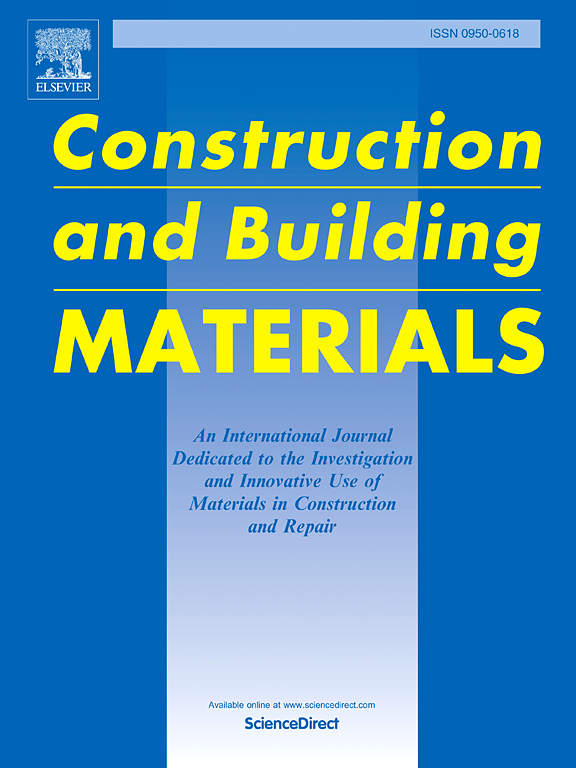Polyvinyl chloride (PVC) waste in pressed geopolymer concrete: Analyzing properties and feasibility application considerations
IF 7.4
1区 工程技术
Q1 CONSTRUCTION & BUILDING TECHNOLOGY
引用次数: 0
Abstract
The problem of waste plastic labels, commonly from polyvinyl chloride (PVC), in the environment, has frequently been disregarded. This study proposed the use of polyvinyl chloride plastic waste (PW) aggregate as a partial substitution for limestone dust aggregate in pressed geopolymer concrete (PG). The PW replacement contents ranged from 0 % to 30 % by volume, and ratios of fly ash-to-aggregate ratio (FA/A) of 0.14, 0.17, and 0.20 by weight were used. PG properties including compressive strength, density, water absorption, porosity, thermal conductivity, ultrasonic pulse velocity, and sound absorption were tested and compared with those of pressed ordinary Portland cement concrete (PC). The results showed that the incorporation of PW led to reduced performances on several concrete properties including reduced compressive strength, and ultrasonic pulse velocity, but other properties including reduced weight, better sound absorption, and lower thermal conductivity were obtained. Such effects were greater in PC than in PG, as demonstrated by a significant reduction in compressive strength of up to 95.5 % in PC, accompanied by considerably higher water absorption and porosity than those of PG. This suggests that geopolymer paste was more compatible with plastic aggregates. Additionally, the production of hollow non-load-bearing geopolymer concrete blocks using PG and PC mixtures was tried. The mix with 20 % PW substitution and 0.20 FA/A ratio met the requirements as per the standard for hollow non-load-bearing concrete masonry units (TIS 58–2017). In addition, an increase in the FA/A ratio tended to improve the properties of the blocks. This study thus provides useful information for producing geopolymer concrete blocks incorporating plastic waste as well as opening up opportunities for further research in this field.
废塑料标签(通常由聚氯乙烯(PVC)制成)在环境中的问题经常被忽视。本研究建议在压制土工聚合物混凝土(PG)中使用聚氯乙烯塑料废料(PW)骨料部分替代石灰石粉骨料。聚氯乙烯废塑料(PW)的替代含量按体积计从 0 % 到 30 % 不等,粉煤灰与骨料的重量比(FA/A)分别为 0.14、0.17 和 0.20。测试了 PG 的性能,包括抗压强度、密度、吸水率、孔隙率、导热率、超声波脉冲速度和吸声率,并与压制的普通硅酸盐水泥混凝土(PC)进行了比较。结果表明,掺入 PW 会降低混凝土的几项性能,包括抗压强度和超声波脉冲速度,但其他性能,包括重量减轻、吸音性能提高和导热系数降低。PC 的抗压强度显著降低了 95.5%,同时吸水率和孔隙率也大大高于 PG,这表明 PC 比 PG 所受的影响更大。这表明土工聚合物浆料与塑料集料的相容性更好。此外,还尝试使用 PG 和 PC 混合物生产空心非承重土工聚合物混凝土砌块。PW 替代率为 20%、FA/A 比率为 0.20 的混合物符合空心非承重混凝土砌块标准(TIS 58-2017)的要求。此外,FA/A 比率的增加往往会改善砌块的性能。因此,这项研究为生产含有塑料废弃物的土工聚合物混凝土砌块提供了有用的信息,同时也为该领域的进一步研究提供了机会。
本文章由计算机程序翻译,如有差异,请以英文原文为准。
求助全文
约1分钟内获得全文
求助全文
来源期刊

Construction and Building Materials
工程技术-材料科学:综合
CiteScore
13.80
自引率
21.60%
发文量
3632
审稿时长
82 days
期刊介绍:
Construction and Building Materials offers an international platform for sharing innovative and original research and development in the realm of construction and building materials, along with their practical applications in new projects and repair practices. The journal publishes a diverse array of pioneering research and application papers, detailing laboratory investigations and, to a limited extent, numerical analyses or reports on full-scale projects. Multi-part papers are discouraged.
Additionally, Construction and Building Materials features comprehensive case studies and insightful review articles that contribute to new insights in the field. Our focus is on papers related to construction materials, excluding those on structural engineering, geotechnics, and unbound highway layers. Covered materials and technologies encompass cement, concrete reinforcement, bricks and mortars, additives, corrosion technology, ceramics, timber, steel, polymers, glass fibers, recycled materials, bamboo, rammed earth, non-conventional building materials, bituminous materials, and applications in railway materials.
 求助内容:
求助内容: 应助结果提醒方式:
应助结果提醒方式:


